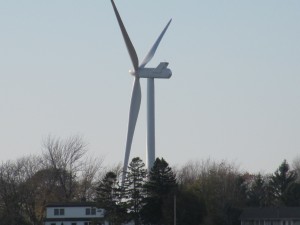
Detailed data in Health Canada study contradicts Ontario government claim 550-metre wind turbine setback is safe
The results of a Health Canada study released November 6 show that Ontario is not protecting the health of residents living near wind turbines, and that longer setbacks between the wind turbines and homes are required.
Health Canada’s summary of its Wind Turbine Noise and Health study results included the fact that responses to the study’s questionnaire show participants reporting experiencing distress or annoyance when wind turbine noise was at 35 decibels/dBA. Current Ontario regulations are based on the World Health Organization Night Noise limit of 40 dBA but that limit was designed solely for traffic and airport noise.
The results of the Health Canada study confirm that wind turbine noise was different than road and airport noise, with issues beginning at 35 dBA. The study also reported that the number of people experiencing disturbance or high annoyance from wind turbine noise was statistically related to several , self-reported health effects such as changes in blood pressure, migraines, tinnitus, dizziness, and perceived stress.
Health Canada had wind turbine noise levels estimated for 1,232 participants in the study, based on their distance from the nearest wind turbine. These data have been released as part of a Freedom of Information request and provide an independent basis to evaluate the setbacks from wind turbines required to protect nearby residents from noises above the 35 dBA level identified in the Health Canada study.
Other jurisdictions including New Zealand and the State of South Australia already use the 35 dBA standard for wind turbine noise, particularly in rural areas.
To protect residents from wind turbine noise over 35 dBA, the noise modelling developed for Health Canada indicates that the setback between turbines and homes should be a minimum of 1,300 metres, not the current 550 metres used in Ontario. The Health Canada report specifically contradicts the Ontario Chief Medical Officer of Health report, released in 2010; 40 dBA is not, therefore, an appropriate noise threshold for wind turbines.
Clearly, more research is needed to establish more appropriate guidelines and regulation.
Validation of what Ontario citizens have been saying to judicial tribunals
“These results validate what the people of rural and small town Ontario have been telling the government, the courts, and the Environmental Review Tribunal for years,” said Wind Concerns Ontario president Jane Wilson. “The Ontario regulations are not based on science, and are not adequate to protect health.”
As Health Canada is the source of these findings, it is expected that these results can be used to show that the current Ontario standard is not sufficient to protect human health. This will be a critical factor in citizen appeals of wind power project approvals, before the Ontario Environmental Review Tribunal (ERT). The Health Canada study is an independent study that validates residents concerns about Ontario’s setback requirements.
The results from Health Canada related to setbacks are likely conservative in nature, Wind Concerns Ontario says: the questions on study participants’ experiences with wind turbine noise were related to experience in the 30 days previous to answering the questionnaire, but, as the survey was delivered in summer, this tactic avoided the problem of the seasonal nature of wind turbine noise. Wind turbine noise tends to be stronger in the fall and spring months, when the weather is windier in Ontario.
Wind Concerns Ontario today called on the federal Health Minister to act on the findings of her department, and issue appropriate interim national guidelines for wind turbines to reflect concerns raised by the study.
Industry had a role in developing regulations
Included in the Wind Concerns Ontario report on how wind turbines are sited, is reference to a letter written to the Ontario government in 2009 by the president of the wind power lobby organization, the Canadian Wind Energy Association, which suggests that industry played a key role in determining Ontario’s setback regulations. Stricter guidelines would have prevented the majority of wind power generation projects proposed at that time, the letter states.
Read the Wind Concerns Ontario analysis and report here:EvaluatingOntarioRegulationsforSitingTurbinesFINAL
Contact us at windconcerns@gmail.com



2 Comments
Marshall Rosenthal
Quelle surprise! I suggest a set-back of AT LEAST TEN MILES FROM THE NEAREST MEGA-WATT WIND TURBINE.
David Libby
Noise Monitoring in the Vicinity of the Waterloo Wind Farm
http://waubrafoundation.org.au/resources/hansen-zajamsek-hansen-noise-monitoring-waterloo-wind-farm/
(Please note the distance of impacts and acoustic emissions extended out further than 8km.)